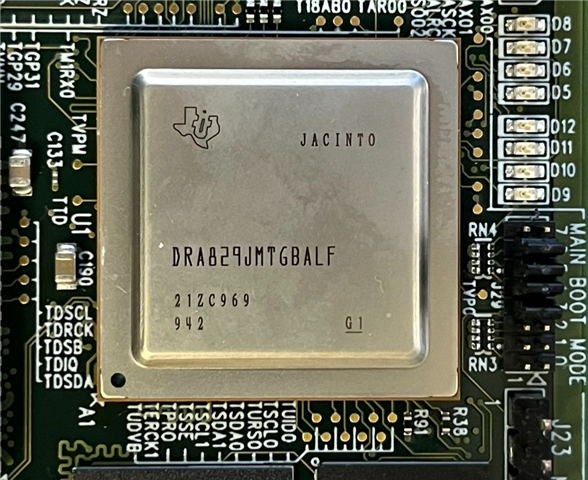Hi,
I have a custom board based on the DRA829J. I'm trying to load tiboot3.bin as the 1st step using dfu-util. Primary boot mode is set to USB DFU. dfu-util seems load tiboot3.bin OK, but I see no output on the MCU UART and the USB DFU device disappears from Windows (using dfu-util running on Windows). We have tried various tiboot3.bin - built using the 08.00 SDK from board-support/u-boot_build/r5/tiboot3.bin and also the .bin that came on the EVM SD card.
c:\asi\sw\ASI2900\bin>dfu-util -l
dfu-util 0.9
Copyright 2005-2009 Weston Schmidt, Harald Welte and OpenMoko Inc.
Copyright 2010-2016 Tormod Volden and Stefan Schmidt
This program is Free Software and has ABSOLUTELY NO WARRANTY
Please report bugs to http://sourceforge.net/p/dfu-util/tickets/
Found DFU: [0451:6163] ver=0200, devnum=27, cfg=1, intf=0, path="1-6.4", alt=1, name="SocId", serial="01.00.00.00"
Found DFU: [0451:6163] ver=0200, devnum=27, cfg=1, intf=0, path="1-6.4", alt=0, name="bootloader", serial="01.00.00.00"
c:\asi\sw\ASI2900\bin>dfu-util -R -a bootloader -D tiboot3.bin
dfu-util 0.9
Copyright 2005-2009 Weston Schmidt, Harald Welte and OpenMoko Inc.
Copyright 2010-2016 Tormod Volden and Stefan Schmidt
This program is Free Software and has ABSOLUTELY NO WARRANTY
Please report bugs to http://sourceforge.net/p/dfu-util/tickets/
Invalid DFU suffix signature
A valid DFU suffix will be required in a future dfu-util release!!!
Opening DFU capable USB device...
ID 0451:6163
Run-time device DFU version 0110
Claiming USB DFU Interface...
Setting Alternate Setting #0 ...
Determining device status: state = dfuIDLE, status = 0
dfuIDLE, continuing
DFU mode device DFU version 0110
Device returned transfer size 512
Copying data from PC to DFU device
Download [=========================] 100% 288976 bytes
Download done.
state(6) = dfuMANIFEST-SYNC, status(0) = No error condition is present
state(2) = dfuIDLE, status(0) = No error condition is present
Done!
can't detach
Resetting USB to switch back to runtime mode
c:\asi\sw\ASI2900\bin>dfu-util -R -a sysfw.itb -D sysfw.itb
dfu-util 0.9
Copyright 2005-2009 Weston Schmidt, Harald Welte and OpenMoko Inc.
Copyright 2010-2016 Tormod Volden and Stefan Schmidt
This program is Free Software and has ABSOLUTELY NO WARRANTY
Please report bugs to http://sourceforge.net/p/dfu-util/tickets/
Invalid DFU suffix signature
A valid DFU suffix will be required in a future dfu-util release!!!
No DFU capable USB device available
Any ideas?.
Thanks
Steve



